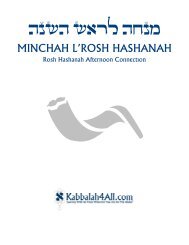Create successful ePaper yourself
Turn your PDF publications into a flip-book with our unique Google optimized e-Paper software.
<strong>K4A</strong> Transliteration Guidelines<br />
Please note that transliteration guidelines are different according to each culture and also within<br />
each movement of Judaism. We have developed these guidelines for use with our transliterated<br />
documents. They may or may not apply to transliterations put out by other movements including<br />
the various organizations teaching Kabbalah.<br />
a as in father<br />
ai as in aisle<br />
e as in red<br />
ei as in eight<br />
i as in pizza<br />
o as in no<br />
oy as in toy<br />
u as in tune<br />
ch as in Bach in German (strong sound from the throat)<br />
g as in give<br />
tz as in lots<br />
’ typically adds an “EH” sound after a consonant, this is known as a Shva Na or pronounced<br />
Shva as in the word “Sh’ma”.<br />
- a dash is simply used to aid in pronounciation, usually if two like vowels follow each other,<br />
as in the word “da-at.”<br />
In Hebrew, the accent generally falls on the last syllable, however it sometimes falls somewhere<br />
else in the word. In our transliteration, when the syllable falls somewhere else other than the last<br />
syllable, that stressed syllable will be underlined. Example: Melech.<br />
Hebrew Rules<br />
The following are some of the Hebrew rules you may notice in our siddurim (connection books).<br />
Kj¤l«¤n In Hebrew, the accent generally falls on the last syllable, however it sometimes falls<br />
somewhere else in the word. Whenever a syllable other than the last is accented, a<br />
“meteg” (the vertical line under the first letter) will appear.<br />
lǨk The “masoret” above the letter Chaf indicates that this is a Kamatz Katan, which is<br />
pronounced as “o”; in this example the word is “kol.”<br />
Egœ§n §U¦i The “rafe” above a letter indicates it is a Shva Na. This example is pronounced<br />
yism’chu.<br />
Note that the rafe does not appear above the first letter of a word that has a Shva<br />
as that is ALWAYS a Shva Na.<br />
Please do not publish or distribute without permission.<br />
All prefaces to prayers written and adapted by David Aharon for Kabbalah4All.<br />
Translated by David Aharon.<br />
Edited by Rebecca Schwartz and David Aharon.<br />
Copyright ©2011 Kabbalah4All.<strong>com</strong>.



